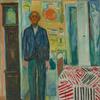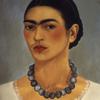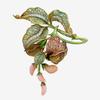Major Botticelli Exhibition Heads to Boston
- BOSTON, Massachusetts
- /
- April 09, 2017
This spring, the Museum of Fine Arts, Boston (MFA), presents the largest exhibition of paintings by Sandro Botticelli (about 1445–1510) ever to be shown in the US. Perhaps more than any other painter, Botticelli exemplifies the artistic achievement of Renaissance Florence in the 15th century, and his signature style of strong contours, lyrical poses and flowing drapery remains instantly recognizable more than five centuries later. Botticelli and the Search for the Divine assembles 15 paintings by the master—loans from museums and churches in Italy, including the world-renowned Galleria degli Uffizi in Florence, as well as three important works from the MFA, the Isabella Stewart Gardner Museum and the Harvard Art Museums. Many of the international loans are on view for the first time in the US, including the life-size Venus (about 1484–90, Galleria Sabauda, Turin)—a reworking of the famous Birth of Venus—produced during the height of Botticelli’s career, during which he enjoyed the support of the powerful Medici family.
The exhibition explores dramatic changes in the artist’s style and subject matter that reflect the shifting political and religious climate of Florence during his lifetime—from poetic depictions of classical gods and goddesses to austere sacred themes that dominate his later production under the influence of the stern Dominican friar Girolamo Savonarola (originator of the infamous “Bonfires of the Vanities”).
Traveling to the MFA as part of a partnership with the Muscarelle Museum of Art at the College of William & Mary, Botticelli and the Search for the Divine (on view April 15 to July 9, 2017 in the Lois B. and Michael K. Torf Gallery) also features a number of paintings by Botticelli’s key contemporaries. Lead support from an anonymous donor. With generous support from The Thompson Family Foundation. Additional support from the Cordover Exhibition Fund and the MFA Associates/MFA Senior Associates Exhibition Endowment Fund. Media sponsor is The Boston Globe. Organized by the Muscarelle Museum of Art at The College of William & Mary in Virginia in partnership with Associazione Culturale Metamorfosi.
“Great art stands as a historical reflection of the time of its creation, and in the moment can encourage all of us to think and act more creatively,” said Matthew Teitelbaum, Ann and Graham Gund Director of the MFA. “Despite deep admiration for Botticelli’s work across the globe, there has never been a major Botticelli exhibition in North America. We are especially pleased to offer the public the opportunity to engage deeply with this period of artistic achievement, Florence in the 15th and early 16th centuries, when Sandro Botticelli was the most famous painter in the city. Although he lived more than 500 years ago, his art still speaks to us directly.”
The selection of paintings in Botticelli and the Search for the Divine encompasses major works from the entire span of the artist’s long and prolific career. The exhibition is organized chronologically, divided into four sections: Botticelli’s artistic formation under his master and principal influence Fra Filippo Lippi; Botticelli’s earliest work and exploration of new genres; his mature years, during which his success reflected remarkable proficiency in depicting erudite literary themes; and his later years, during which he produced profoundly religious paintings, not well known today, under the sway of Savonarola.
“Our exhibition traces a fascinating story of an artist shaped by tumultuous times. We hope to bring our visitors into Botticelli’s Florence, a city full of brilliant painters and opinionated patrons, with our artist often caught in the middle,” said Frederick Ilchman, Chair, Art of Europe and Mrs. Russell W. Baker Curator of Paintings at the MFA. “Since Botticelli was one of the most versatile artists of the Italian Renaissance, we’re also excited that our exhibition will include a wide variety of subject matter and a surprising range of media. American audiences will be able to experience the full scope of the artist’s achievement firsthand, thanks to unprecedented loans from Italy, as well as generous loans from Boston institutions.”
The son of a tanner, Botticelli received early training as a goldsmith before joining the studio of painter Fra Filippo Lippi (about 1406–69) for an apprenticeship that lasted from approximately 1460 to 1467. Several of Lippi’s depictions of the Madonna and Child—one of his specialties—are displayed, including the majestic Madonna and Child (about 1466–69, Palazzo Medici Riccardi, Florence), which shows the figures in a touching embrace, before a grand architectural backdrop. Lippi’s graceful, ornamental style made a strong impression on Botticelli, who emulated his teacher’s gift of expressing deeply felt tenderness. While Botticelli’s earliest paintings included copies of his master’s compositions, the Virgin and Child (Madonna of the Loggia) (about 1467, Galleria degli Uffizi, Florence) is generally regarded as one of the younger artist’s earliest independent renditions of a sacred theme that would become one of his own specialties.
Botticelli established his own workshop in about 1470. His assistants included his master’s son, Filippino Lippi (about 1457–1504), who distinguished himself as Botticelli’s best pupil after initial training with his father. Similar compositions can be seen in the younger Lippi’s Adoration of the Child with Saint John (about 1485, Galleria degli Uffizi, Florence) and Botticelli’s tondo, or round painting, The Nativity (about 1482–85, Isabella Stewart Gardner Museum).
A rare loan from the Church of San Salvatore in Ognissanti, Florence, Saint Augustine in His Study (about 1480), was Botticelli’s first major fresco and the most important work on public view by the artist during his lifetime. The success of the image, which portrays the patron saint of humanism as a powerful older man with large, sculptural hands and a mood of solemn grandeur, likely explains why Botticelli received soon after commissions for more frescoes than any other painter on the walls of the Sistine Chapel in Rome.
After a year in Rome, Botticelli returned to Florence. The decade that followed marked the peak of his career, closely intertwined with patronage from Lorenzo the Magnificent, ruling member of the Medici dynasty. Lorenzo’s emblem of linked diamond rings can be seen on the dress of the heroine subduing a mythical creature in Botticelli’s Minerva and the Centaur (about 1482, Galleria degli Uffizi, Florence). The painting was possibly commissioned by Lorenzo as a wedding gift for his cousin Lorenzo di Pierfrancesco, who in turn commissioned Botticelli’s most iconic work—the Birth of Venus, painted around 1484. Responding to the immediate enthusiasm for his masterpiece, Botticelli replicated his portrayal of the nude goddess of love— itself based on a famous lost marble statue from antiquity—a number of times. The Venus on view in the exhibition is one of only two surviving versions, perhaps executed by the master with the help of an assistant. Its superb quality indicates the high standards of the workshop. Standing on a narrow stone parapet, Venus is silhouetted against a black background strongly lit from the right, as if to evoke a sculpture. A transparent sleeved garment with a square neckline opens just below her chest, and her shoulders descend to her arms in the same stream of movement as her floating hair.
The golden age of the Medici court ended abruptly when Lorenzo the Magnificent died in 1492. As had become the custom in Tuscany for great men, a funerary mask (1492, Gallerie degli Uffizi, Tesoro dei Granduchi) was modeled from his face in order to preserve the effigy of Florence’s foremost citizen. Lorenzo was succeeded by his son, Piero the Unfortunate, who was soon exiled along with the entire Medici family after a series of disastrous decisions that left Florence defenseless against an invasion led by the French king, Charles VIII. In this vacuum, an adversary of the Medici, Fra Girolamo Savonarola (1452–98), persuaded the French king to grant the city more lenient terms of surrender. The citizens of Florence ceded their government to Savonarola, who used forceful and apocalyptic sermons to insist on harsh moral reforms. In 1497 and 1498, he organized two “Bonfires of the Vanities,” during which thousands of books, paintings and other possessions associated with temptation and sin were set on fire. Botticelli is the most prominent among the artists whose depictions of nudes and pagan subjects were likely burned—and some authorities believe that Botticelli himself was a willing participant, throwing his own paintings itno the flames.
While there are no records that Botticelli ever personally met Savonarola, he must have heard him preach often. Many scholars believe that changes in the artist’s style are partially in response to the cultural and societal changes caused by the friar’s reign. In this last chapter of his career, Botticelli progressively simplified his style by reducing his color palette, flattening the figures and rounding their contours, as well as filling the background and suppressing the sense of spatial depth.
Intended for private devotion, the MFA’s Virgin and Child with Saint John the Baptist (late 1490s) possesses the characteristics of Botticelli’s later manner. In comparison with his earlier depictions of the subject, a certain stiffness can be observed in the profiles of the figures and in the drapery folds. Virgin and the Child with Young Saint John the Baptist (about 1505, Galleria Palatina, Palazzo Pitti, Florence) offers an even more austere and solemn portrayal. Holding the Christ child, the Virgin Mary bends forward and lowers her son to the young St. John the Baptist, alluding to Christ’s later descent from the cross. The painting has long been considered one of Botticelli’s most enigmatic works, probably completed between the execution of Savonarola in 1498 and the painter’s death in 1510.
Despite enormous popularity, Savonarola’s success did not go unchallenged—he was banned from preaching and excommunicated by Pope Alexander VI in 1497. The friar boldly agreed to a trial by fire in 1498, closely followed by his arrest and conviction of heresy. In May, Savonarola was hanged and burned by secular authorities. Botticelli’s Mystic Crucifixion (about 1500, Harvard Art Museums) is believed to be a response to the execution, which occurred only a few months after the second Bonfire of the Vanities. The painting incorporates themes from Savonarola’s catastrophic sermons, with firebrands and weapons raining from the sky and an angel of justice raising a sword to slay a small lion that symbolizes Florence. The city itself appears in the background, cast in a heavenly light.
In addition to paintings, the exhibition in Boston includes rare books, engravings and woodcuts that help bring to life the rich cultural context of Florence in the era of the Medici and Savonarola. A rare 1481 edition of Dante’s Divine Comedy (Isabella Stewart Gardner Museum), for which Botticelli designed engraved illustrations, exemplifies the esteem for erudition in Lorenzo the Magnificent’s court and his promotion of Florence as the center for intellectual pursuits. Savonarola’s own writings will be present through two books of theology from the MFA’s collection.

270x400_c.jpg)









100x100_c.jpg)







